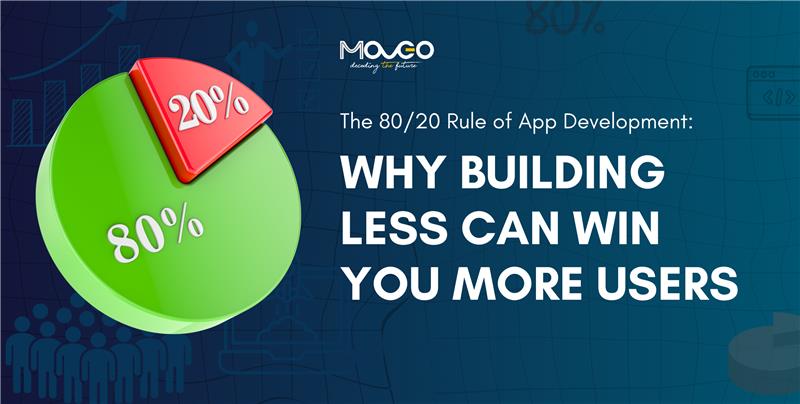In the rush to impress investors, satisfy internal teams, or match the competition, app development teams often scram to build as many features into their apps, that the app ends up looking bloated and slow-moving. UX design suffers and users gravitate towards simpler alternatives.
But, more features usually don’t mean more value, they mean more complexity, and more ways for users to get lost. Moreover, too many features delay your launch and eat through your budget before you even see your first 1,000 downloads.
In reality, most users only care about a small fraction of your app’s features – the ones that solve their biggest problems quickly and intuitively. Everything else is just noise. The 80/20 rule in app development is a reminder that 80% of your app’s value often comes from just 20% of its features.
When you focus on identifying and perfecting that critical 20%, you not only build an app that’s easier to use, but you also release it faster, with fewer bugs, and at a lower cost. As downloads begin rolling in, you can add more features incrementally, allowing you to gauge audience preferences, and fine tuning your product.
It’s not about offering “less” to users. It’s about offering more of what matters. And in today’s crowded app stores, that can be the difference between becoming an app they use daily, versus being uninstalled within a week.
What is the 80/20 Rule in App Development?
The 80/20 rule, also known as the Pareto Principle, is a simple caveat. It states that in most situations, 80% of results come from just 20% of the efforts. In product development, that means the bulk of user engagement usually comes from a small, high-value subset of your app’s features.
Think about it – How many buttons on your TV remote do you actually press every day? For most people, it’s 5. The power button, volume, channel up/down, back button, and maybe that dedicated Netflix button. Everything else is largely ignored.
Apps are no different.
Research shows that the majority of mobile interactions happen within a small set of core features. That’s why apps like Instagram took off by starting small — just photo sharing — before layering in stories, reels, and shopping over years of growth.
In other words: build for the buttons they press, not the ones you hope they’ll discover.
Are There Pitfalls of Building Too Many Features Before Launch?
Trying to launch with everything from day one might feel like you’re giving users more value, or launching the ‘perfect’ product. In reality, you’re just giving yourself more problems.
- Higher Development Costs – Every feature has to be designed, coded, tested, and integrated. More features mean more engineers, longer QA cycles, and more billable hours burning through your budget.
- Slower Releases – While you’re still perfecting Feature #14, a competitor can launch with their core offering, start gathering feedback, and begin improving while you’re still stuck in pre-launch mode.
- Confused Users – First-time users don’t read manuals. A cluttered interface forces them to guess their way around, causing decision fatigue and early drop-offs.
- Maintenance Headaches – Every new OS update, device variation, or bug fix is multiplied by the number of features you’ve crammed in. That’s a lot of plates to keep spinning.
Consider Twitter (now X). It launched as a bare-bones microblogging tool. Just short text updates. If they’d waited for DMs, threads, image uploads, and Spaces before going live, they might have missed the early traction that made them a household name. Humble beginnings of Twitter are a masterclass in product development.
How to Pick the 20% Features That 80% Users Will Love?
So how do you decide what makes the 20% cut? Here are three battle-tested frameworks you can use with your dev team:
1. MoSCoW Method
A popular prioritization framework used by product and development teams, MoSCoW helps separate must-haves from nice-to-haves so your MVP stays focused and avoids feature bloat.
- Must have – Without these, your app has no reason to exist.
- Should have – Adds value, but not critical for launch.
- Could have – Nice-to-have features for later.
- Won’t have (for now) – Park it for a future release.
How to use: Run a workshop, list every feature, and drop them into these four buckets. Only the ‘Must Haves’ should be a part of your MVP. Everything can wait. this doesn’t mean you’re dropping those features you so wanted to have in your app. it just means you’re waiting for the right time and traction before you can add layers of functionality.
2. RICE Scoring
RICE is a scoring system often used by growth teams and product managers to prioritize features based on impact, reach, confidence, and effort. It ensures your decisions are data-informed, not just gut-feel.
- Reach – How many users will it impact?
- Impact – How much value will it add?
- Confidence – How sure are you about the reach/impact?
- Effort – How much work will it take?
How to use: Assign scores to each metric, then tackle features with the highest RICE score first.
3. Kano Model
The Kano Model, widely used by UX designers and product teams, classifies features based on necessity and user delight. It helps you balance essential features with unexpected touches that create loyalty.
- Basic needs – If missing, users leave instantly.
- Performance features – The more you offer, the better.
- Delighters – Unexpected touches that spark loyalty.
How to use: Map your features into these buckets, making sure your MVP covers basic needs and includes at least one or two performance wins.
What Are Some Benefits of Starting Smaller?
Starting small isn’t about playing it safe — it’s about playing it smart. Think of it like launching a restaurant with a signature dish rather than a 20-page menu. You focus on what you can perfect, win loyal customers, and then expand based on what they actually order.
Lower Costs, Faster Launch
Every extra feature is like adding another course to that restaurant menu — more ingredients, more prep time, and more expense. By starting with just your “signature dish,” you save resources and get your product out the door sooner. That early launch means real-world feedback starts coming in while competitors are still in the kitchen.
Better Feedback Loops
When you only have a few features in play, it’s much easier to see what’s working and what’s not. It’s the difference between tracking three ingredients in a recipe versus tracking thirty, you instantly know what’s adding flavor and what’s not pulling its weight. This lets you adapt and improve with precision.
Higher Adoption Rates
A focused, lean app is less intimidating for new users. They don’t need a manual or onboarding marathon, they can just dive in and start using it. The learning curve is short, and the sense of mastery comes fast, which makes people far more likely to stick around.
Easier Scaling
When you grow from a smaller base, every new feature you add has a proven reason to exist. You’re not guessing. You’re responding to validated needs. This prevents wasted development cycles on flashy extras that don’t actually move the needle, and it keeps your product clean, intuitive, and future-ready.
The Final Word
The 80/20 rule in app development isn’t about cutting corners, it’s about cutting noise. In an industry that often glorifies complexity, the most successful founders are the ones who have the courage to simplify. They resist the temptation to impress with a laundry list of features and instead focus on delivering one or two things better than anyone else.
When you start small, you give your app — and your business — room to breathe. You’re not just saving time and money; you’re creating an environment where real feedback can shape your direction. This isn’t theory. At MoveoApps, we’ve seen apps double their adoption rates, raise funding faster, and scale more sustainably simply because they chose to launch lean.
And here’s the paradox – starting small doesn’t mean thinking small. The greatest apps today, the ones topping charts, began with razor-sharp focus. WhatsApp launched as a simple status-updating app before it became a global communication giant. Instagram started as a photo-sharing tool without video, reels, or shopping. They grew because they earned the right to grow, one proven feature at a time.
Your first version is not your final word. It’s your opening line in a conversation with your users. The cleaner and clearer that line is, the more likely your users are to respond, engage, and stick around. From there, the rest of your story can unfold based on what people actually want, not what you assumed they might want.
So, if you’re planning your next app launch, think less about building an “everything app” and more about building an unmissable app. Focus on the 20% of features that will bring 80% of the impact, and you’ll set yourself up not just for a successful launch, but for sustainable, compounding growth.


